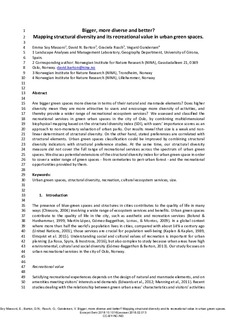| dc.contributor.author | Soy Massoni, Emma | |
| dc.contributor.author | Barton, David Nicholas | |
| dc.contributor.author | Rusch, Graciela | |
| dc.contributor.author | Gundersen, Vegard | |
| dc.date.accessioned | 2018-04-09T11:01:35Z | |
| dc.date.available | 2018-04-09T11:01:35Z | |
| dc.date.created | 2018-03-12T12:23:56Z | |
| dc.date.issued | 2018-03-07 | |
| dc.identifier.issn | 2212-0416 | |
| dc.identifier.uri | http://hdl.handle.net/11250/2493209 | |
| dc.description.abstract | Are bigger green spaces more diverse in terms of their natural and manmade elements? Does higher diversity mean they are more attractive to users and encourage more diversity of activities, and thereby provide a wider range of recreational ecosystem services? We assessed and classified the recreational services in green urban spaces in the city of Oslo, by combining multidimensional biophysical mapping based on the structural diversity index (SDI), with users’ importance scores as an approach to nonmonetary valuation of urban parks. Our results reveal that size is a weak and non-linear determinant of structural diversity. On the other hand, stated preferences are correlated with structural elements. Urban green spaces classification could be improved by combining structural diversity indicators with structural preference studies. At the same time, our structural diversity measure did not cover the full range of recreational services across the spectrum of urban green spaces. We discuss potential extensions of the structural diversity index for urban green space in order to cover a wider range of green spaces – from cemetaries to peri-urban forest – and the recreational opportunities provided by them. Urban green spaces Structural diversity Recreation Cultural ecosystem services Size | nb_NO |
| dc.language.iso | eng | nb_NO |
| dc.rights | Attribution-NonCommercial-NoDerivatives 4.0 Internasjonal | * |
| dc.rights.uri | http://creativecommons.org/licenses/by-nc-nd/4.0/deed.no | * |
| dc.subject | Urban green spaces | nb_NO |
| dc.subject | Structural diversity | nb_NO |
| dc.subject | Recreation | nb_NO |
| dc.subject | Cultural ecosystem services | nb_NO |
| dc.subject | Size | nb_NO |
| dc.title | Bigger, more diverse and better? Mapping structural diversity and its recreational value in urban green spaces | nb_NO |
| dc.type | Journal article | nb_NO |
| dc.type | Peer reviewed | nb_NO |
| dc.description.version | acceptedVersion | nb_NO |
| dc.subject.nsi | VDP::Samfunnsvitenskap: 200::Økonomi: 210 | nb_NO |
| dc.source.journal | Ecosystem Services | nb_NO |
| dc.identifier.doi | 10.1016/j.ecoser.2018.02.013 | |
| dc.identifier.cristin | 1572104 | |
| dc.relation.project | EC/FP7/OpenNESS (Grant agreement no. 308428) | nb_NO |
| dc.relation.project | Norges Forskningsråd: 160022 | nb_NO |
| cristin.unitcode | 7511,6,0,0 | |
| cristin.unitcode | 7511,2,0,0 | |
| cristin.unitcode | 7511,5,0,0 | |
| cristin.unitname | Oslo | |
| cristin.unitname | Avdeling for terrestrisk økologi | |
| cristin.unitname | Lillehammer | |
| cristin.ispublished | true | |
| cristin.fulltext | postprint | |
| cristin.qualitycode | 1 | |

